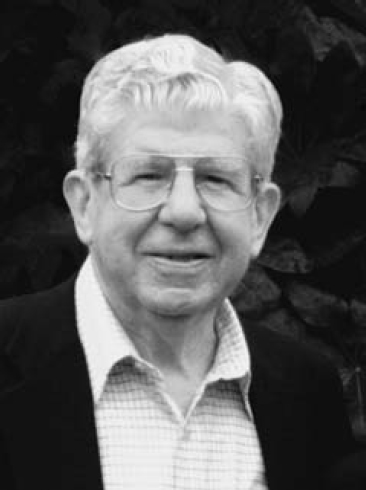
1922–2010
Elected in 1980
“For leadership in a major offshore engineering achievement which has advanced deepwater oil production technology.”
BY R. LYNDON ARSCOTT
GLENN AUGUST SCHURMAN died peacefully at home in Tiburon on December 30, 2010, after a two-year battle with cancer.
He was born on September 6, 1922 and raised on a small dairy farm in Woodland, Washington. Glenn graduated from Washington State University in 1944 with a degree in mechanical engineering. He joined the Air Corps Enlisted Reserve and was assigned to the National Advisory Committee for Aeronautics Research (later to become the National Aeronautics and Space Administration) Laboratory in Cleveland, Ohio, working on development of the jet engine. At the end of World War II, he attended the California Institute of Technology in Pasadena, earning a Ph.D. in mechanical engineering.
In 1950 Glenn joined Chevron Corporation at its new research facility in La Habra, California, working on early developments in geophysical instrumentation and helping pioneer the field of offshore drilling and development. He was awarded 18 patents for technical inventions in various aspects
of oil and gas exploration and production. After 12 years at the La Habra Research Center, having attained the position of manager of production operations, he moved to New Orleans to supervise production operations in the Mississippi Delta. Glenn spent six years in New Orleans before relocating to Midland, Texas, in 1969 as manager of production operations for Texas, New Mexico, and Arizona.
During this three-year assignment, he supervised installation of the first commercial CO2 flood in the Snyder field, Texas. This was a period in the oil industry when enhanced recovery was just starting to bloom, and this project was watched closely by the industry. The giant Snyder project (SACROC unit) had 1,256 wells and had produced 500 million barrels of oil by 1972. The new project required CO2 to be transported through a 220-mile pipeline from the Val Verde Basin gas fields in southwestern Texas to the SACROC unit. This required 81,000-HP compressors to deliver the CO2 at a pressure of 2,400 psi to the 202 injection wells. The project was very successful, and injection continues to this day.
In 1972, Glenn moved back to New Orleans as assistant general manager of operations for a period of two years. His next assignment as vice president of production for the Rocky Mountain Division was cut short after six months because of the urgent need for someone of Dr. Schurman’s ability to go to London as managing director of Chevron’s U.K. properties. In 1975, Chevron had just taken over operatorship of the Ninian field, which at that time was the third largest in the U.K. North Sea.
This was an important period in the history of the oil industry because the billion barrel oil fields recently discovered in the North Sea required innovative technology to be successful in the hostile environment of the North Sea. During this period, the first massive concrete structures were constructed for such giant fields as Ekofisk, Beryl, Statfjord, and Ninian. Glenn’s task was to coordinate the myriad interests of the Ninian partners, contractors, government agencies, and public concerns to build, install, and produce oil and gas in a hostile environment while meeting all the required safety and environmental
requirements. The Ninian Central Platform, weighing 600,000 tonnes, was at that time the biggest structure ever floated to a location. It was built at the Doris facility in Loch Kishorn, Scotland, using the slip-forming technique in which concrete is placed in layers into well formworks continuously raised by hydraulic jacks. The diameter at the base was 140 m and the height was 156 m. The steel deck was constructed at a separate site and weighed 6,700 tonnes. It was decided to place the deck onto the platform at the construction site. The steel deck was transferred to two catamaran barges for transit to the mating site. The concrete platform was submerged to 13 m of freeboard, and then the deck was floated over it. Deballasting the platform then commenced to accept the deck weight and release the barges. This was the first submergence mating of a complete deck in the United Kingdom. The platform was successfully installed on location in May 1978 after an 11-day tow of 480 miles. In recognition of his achievement in successfully managing this enormous project, the British government awarded him an honorary CBE (Commander of the British Empire).
Glen returned to San Francisco in 1981, joining Chevron’s home office staff as corporate vice president for oil field development and operations worldwide. During this period Glenn helped merge the production operation of Chevron and Gulf Oil Company. He retired in 1987.
Glenn was a member of the Society of Petroleum Engineers, the American Society of Mechanical Engineers, and Tau Beta Pi, and he was a registered professional engineer in the state of California. He was elected to the National Academy of Engineering in 1980. He is a distinguished alumnus of Washington State University and the California Institute of Technology.
Glenn was devoted to his work but always made time for his wife, Patricia, and their three children. He enjoyed early mornings on the golf course, camping on lakes and rivers throughout California, and summer vacations visiting national parks. Glenn was an amateur photographer and documented the life of his children and grandchildren using the latest
developments in film and video. Glenn and Pat shared many good times at Sweet Adeline performances and competitions in New Orleans, Denver, London, and San Francisco. During their stay in London, they traveled throughout Europe and visited China, Russia, and India. After Glenn’s retirement, they continued their travels and hosted family reunions for their children and seven grandchildren. Glenn lived a rich, full life and is survived by his wife of 66 years, Patricia, his three children, and their families.






